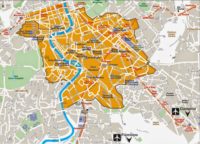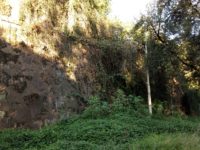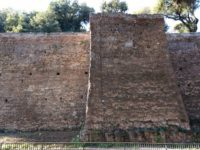I didn’t set out to go on a hero’s journey, complete with call to adventure, ordeal by forces of supernatural power, abyss-despair-failure, overcoming all hardships to gain the reward, but that’s what ended up happening. This is the final part of the quest, wherein I return with the treasure to benefit humanity. So, like, you guys.
The story begins on September 20th, 1870, when the army of the Kingdom of Italy, then less than a decade old, breached the ancient Aurelian Wall at Porta Pia to wrest Rome from the white-knuckle grip of Pope Pius IX and make it the capital of a truly unified Italy. The date and the breach of the walls has gone down in history with a spin that’s more legend than fact. The army did “besiege” the city, but the siege amounted to three hours of cannon fire against the walls.
If you’re thinking that maybe it’s not all that remarkable that a few hours of cannon fire would breach a 1600-year-old wall peppered with holes, cave-ins, crumbling ramparts and patchwork repairs, you are wise. The Pope’s resistance was token. He knew it was over; he just didn’t want to go down without some pretense at fighting back. After those three hours of artillery lobbed at Porta Pia, 72 troops — 53 Italian and 19 papal — were dead and the kingdom’s forces made their triumphal entry down the Via Pia, today named Via XX Settembre after that momentous day.
Nowadays, the Aurelian Wall at Porta Pia is a snarl of traffic with the modern version of the ancient consular roads transporting an endless parade of cars, motorini and buses both tourist and public. The Corso d’Italia, fat with lanes and divides and over and underpasses, runs along the outside of the wall past the former Porta Salaria (demolished in 1921) to the Porta Pinciana.
 Somewhere between the Porta Pia and Pinciana, embedded high on a tower of the Aurelian Wall is a single cannon ball that was shot during the siege of September 20th. As I had already determined to walk as many tracts of the ancient wall I could manage, I thought it would be groovy to cap one of those walks with a picture of the 1870 cannon ball in the 270s wall. I knew from my childhood days that the Borghese Gallery is right across from the Pinciana Gate north of the city, its massive park stretching out below the villa itself practically all the way down to the Porta del Popolo, the gate adjacent to the church of Santa Maria del Popolo famous for its Caravaggio paintings. The stretch of Aurelian Wall that goes up the hill from the Porta del Popolo towards the Porta Pinciana still stands. It’s called the Muro Torto (crooked wall, after a sharp dogleg east) and when I was a kid, I had a distinct fixation with it, staring at the looming structure whenever we drove by it. I was looking forward to experiencing that looming feeling even more keenly walking at its feet.
Somewhere between the Porta Pia and Pinciana, embedded high on a tower of the Aurelian Wall is a single cannon ball that was shot during the siege of September 20th. As I had already determined to walk as many tracts of the ancient wall I could manage, I thought it would be groovy to cap one of those walks with a picture of the 1870 cannon ball in the 270s wall. I knew from my childhood days that the Borghese Gallery is right across from the Pinciana Gate north of the city, its massive park stretching out below the villa itself practically all the way down to the Porta del Popolo, the gate adjacent to the church of Santa Maria del Popolo famous for its Caravaggio paintings. The stretch of Aurelian Wall that goes up the hill from the Porta del Popolo towards the Porta Pinciana still stands. It’s called the Muro Torto (crooked wall, after a sharp dogleg east) and when I was a kid, I had a distinct fixation with it, staring at the looming structure whenever we drove by it. I was looking forward to experiencing that looming feeling even more keenly walking at its feet.
 Such was my call to adventure. The ordeals began with a “sidewalk” that could only have been designed by forces of supernatural malignity. Sometimes it was wide enough for two feet. Sometimes it wasn’t. More than once it was a line painted on asphalt, literally forcing my back against the wall, hands clutching the clammy grunge of masonry and brick as cars sped past me so fast they made a laser-like “pew!” sound. When there was sufficient sidewalk to lower the risk from almost certainly deadly to “danger Will Robinson” flailing, new enemies sprang up in the form of weeds. The embankments and sides of the walls were choked with vegetation, so much so that I feared I’d miss the cannon ball hidden in cascades of wild plants.
Such was my call to adventure. The ordeals began with a “sidewalk” that could only have been designed by forces of supernatural malignity. Sometimes it was wide enough for two feet. Sometimes it wasn’t. More than once it was a line painted on asphalt, literally forcing my back against the wall, hands clutching the clammy grunge of masonry and brick as cars sped past me so fast they made a laser-like “pew!” sound. When there was sufficient sidewalk to lower the risk from almost certainly deadly to “danger Will Robinson” flailing, new enemies sprang up in the form of weeds. The embankments and sides of the walls were choked with vegetation, so much so that I feared I’d miss the cannon ball hidden in cascades of wild plants.
But the obstacle that would defeat me, seemingly ending my quest, was road work. I wasn’t even at the top of the hill when the sidewalk and right lane were taped off for some pressing infrastructure modification project. Being in Rome, I did as any Roman would do and simply ducked under the tape to continue on my not-so-merry way. I was chased out by a supernatural apparition only spoken of in hushed tones in this city but never seen: an actual worker working.
 Now I was on the street, a target for high-speed vehicles and their eardrum-shattering horns. Again I had to walk feet splayed outwards, heels together, in the few inches of gutter space that made the difference between life and death. If the cannonball had appeared during that stretch, there was no way I could have seen it.
Now I was on the street, a target for high-speed vehicles and their eardrum-shattering horns. Again I had to walk feet splayed outwards, heels together, in the few inches of gutter space that made the difference between life and death. If the cannonball had appeared during that stretch, there was no way I could have seen it.
Finally at the top of the hill but not even at the Porta Pia yet, the wall disappeared. The last I could see of it ended in a piney private park far above me. I had to admit defeat. Crushed, bereft of cannonballs, I lost hope and had to find a new reason to go on. I walked heavily down the steps to the Spagna Metro station and made my way to the patrician domuses under the Palazzo Valentini in Trajan’s Forum where I had booked a tour.
It turned out to be an epic tour and will be a topic for its own chanson de geste, but it could not erase the memory of my lost cannonball. It would be the Aurelian Wall itself that would resuscitate the deceased hope that I might achieve my quest after all.
Pics or it didn’t happen! Youcan’t say such unbelievable things without pictorial proof!
Sorry I couldn’t resist *evil grin*
Why didn’t Emperor Honorius think of using non-working Roman municipal workers and yellow “Do Not Cross” papyrus strips to chase the Visigoths out of Rome? It might just have worked.
Here you go, to the lower right of the hanging light:
http://heritagetimes.eu/wp-content/uploads/2017/06/IMG_3953-1024×964.jpg
No spoilers!
𐌽𐌰𐌹𐍃 𐍊𐍂𐌰𐌹 😆 – Vadete retro, Romani!!! 👿
You were lucky, even if not with your quest for the cannonball.
Following your departure, Italy has been hit by quite remarkable storms, which have left at least ten people dead and a lot of damage. Rome was subject to serious flooding.
The weather was driven by the south wind, or Scirocco. After the worst of the gale force storm had passed over us, I had a bit of cleaning up to do before dawn. The thunderous clouds were heading for Florence and Pisa to do their worst, but even through the clouds still above me the silent, high-level lightning was bright enough to read the newspaper – I checked.
You are well out of it. I have experienced massive storms in the Scottish mountains, but this one impressed me.